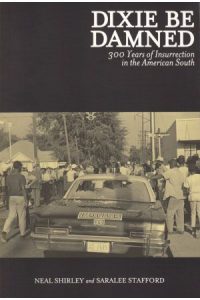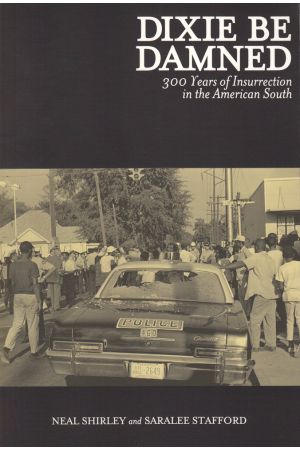Dixie Be Damned (rebroadcast)

This week, we’re excited to (re-)present a 2015 conversation with Saralee Stafford and Neal Shirley, editors and authors of their book out from AK Press entitled “Dixie Be Damned: 300 years of Insurrection in the American South”. The book is a study of Maroon, Indigenous, White, Black, worker, farmer, slave, indentured, women and men wrestling against institutions of power for autonomy and self-determination. All of this in a region stereotyped to be backwards, slow, lazy, victimized and brutal. The editors do a smash-bang job of re-framing narratives of revolt by drawing on complex and erased examples of cross-subjectivity struggles and what they can teach us today about current uprisings in which we participate.
Throughout the hour we explore some of the examples that became chapters in the book, critiques of narrative histories and academia and what new ways forward might be towards an anarchist historiography.
Announcements
Benefit for Pepe from DIY-Bandits
Asheville-based punk collective called Bandits Never Die, in conjunction with the DIY-Bandits label, is doing an online fundraiser for Pepe, the founder of DIY-Bandits who is doing time in Federal prison. We interviewed Pepe before he went in in 2019, you can find a link in the show notes about his reflections of preparing for prison and what he’d learned about the realities of families of people serving time in the BOP. The benefit is a limited time print of a t-shirt and or poster and 100% of proceeds will go to support Pepe while he’s in prison (https://banditsneverdie.bandcamp.com/merch/i-want-to-believe-t-shirt-poster-combo). You can also see Q&A’s and some videos of Pepe before he went inside at his blog, https://preparingforfreedom.org
Giannis Dimitrakis
Anarchist bank robber and prison rebel in Greece is still healing from the attack he suffered at Domokos prison at the hands of guards under the New Democracy administration. G. Dimitrakis was held for a period in solitary confinement after the attack rather than be transported to a hospital to help treat his serious wounds, likely as an attempt to inflict permanent damage or kill the rebel. There is a new letter from Mr Dimitrakis that was kindly translated into English by comrades in Thessaloniki available on June11.org that we invite listeners to check out and will link in our show notes, alongside the original Greek. You can also find his firefund to raise court costs to argue for a quick release for Giannis Dimitrakis at firefund.net/giannis. Our Passion for Freedom is Stronger Than Their Prisons!
TFSR Housekeeping
As a quick reminder, you can find transcripts of each weekly episode of our show at our website by clicking the Zines tab, as well as on each episode’s page. We also have choice past episodes transcribed and available for easier reading, translation, printing and mailing.
If you want to support TFSR’s transcription work, you can visit TFSR.WTF/support and find a few ways to donate to us, one time or recurring, or by buying stickers or shirts as merch. If you sign up to support us via patreon.com/tfsr you can find thank you gifts as well. Thanks to our transcribers, zinesters and those who support us by sharing us with their communities and on social media. We also air on a dozen or so radio stations around the country, more on how to tune in or how to help us get on more airwaves at TFSR.WTF/radio.

